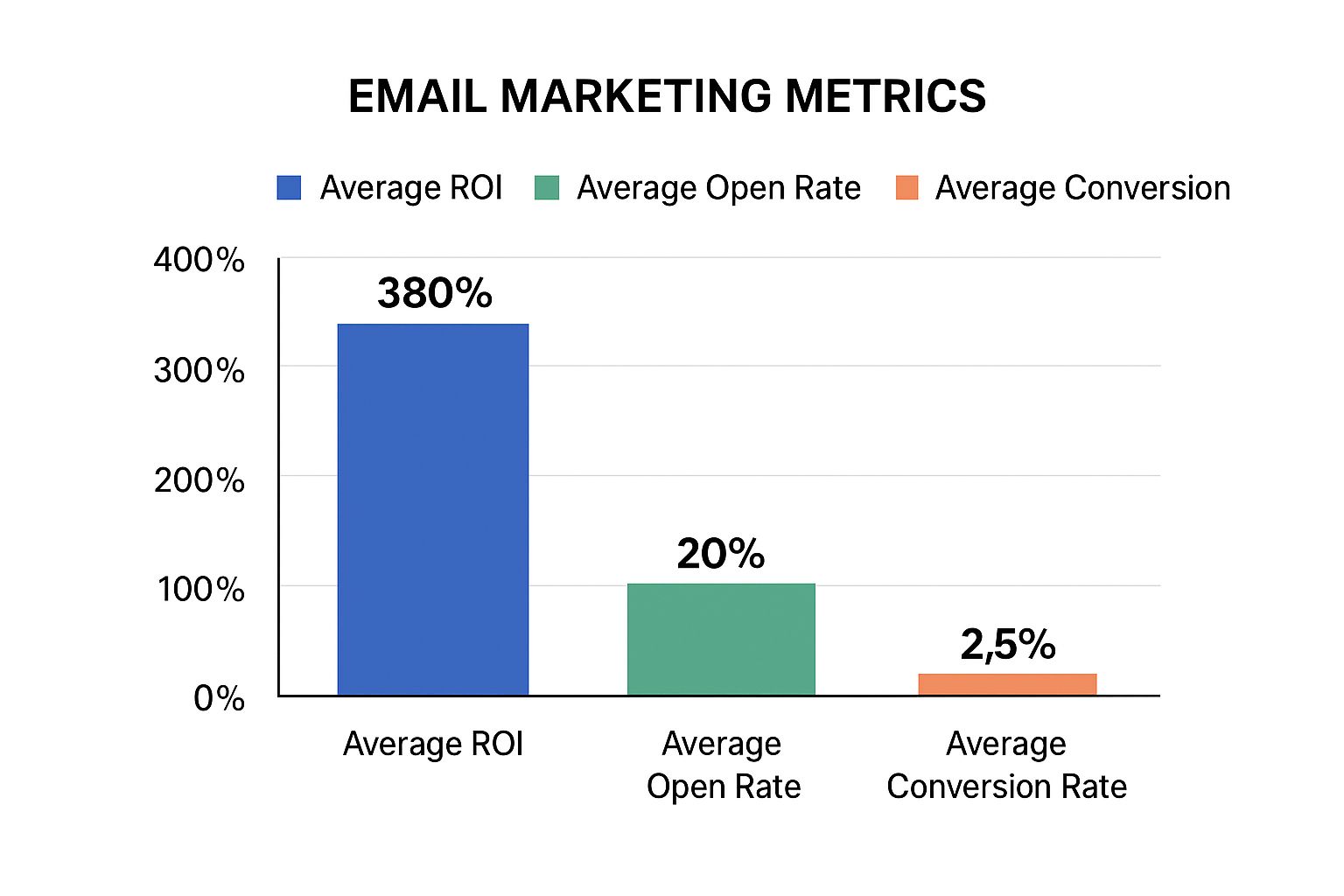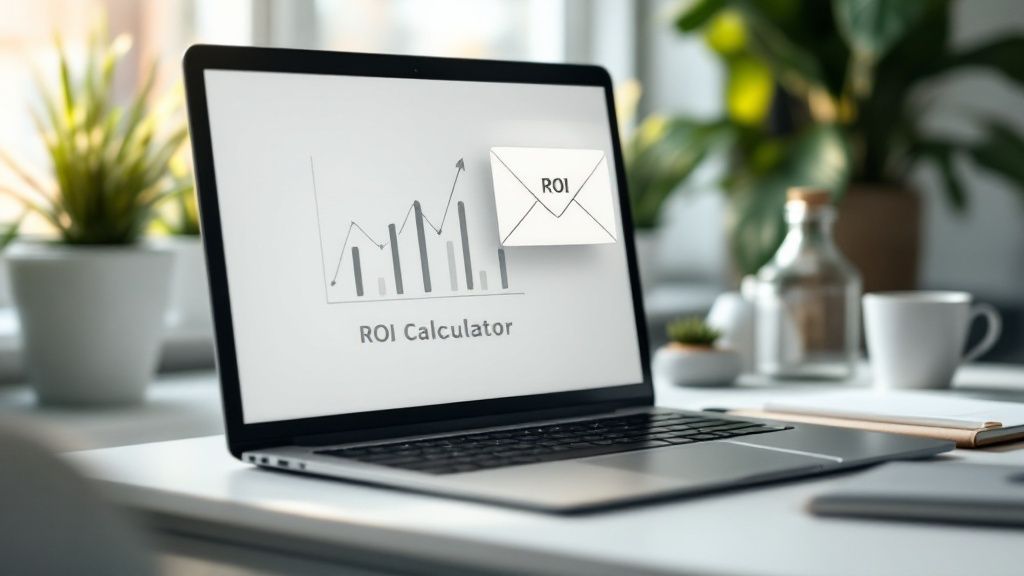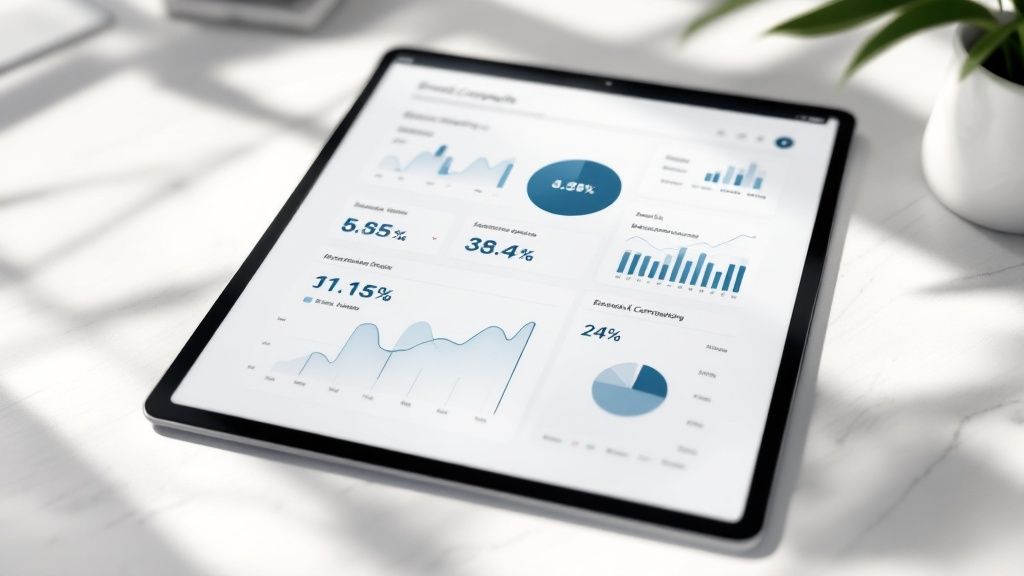Boost Your Email Marketing ROI with Proven Strategies
May 12, 2025

The Real Value of Email Marketing ROI: Beyond the Hype

The infographic above illustrates three key email marketing metrics: average ROI, average open rate, and average conversion rate. Email boasts a substantial average ROI of 380%, considerably higher than its average open and conversion rates.
This underscores email's ability to deliver substantial returns even with modest engagement figures. For those looking to improve conversion rates, this resource offers valuable insights: How to master boosting your email marketing conversion rates.
Understanding the Email Marketing ROI Formula
Calculating email marketing ROI is simple: (Revenue – Investment) / Investment x 100. This formula reveals the revenue generated for every dollar invested in email marketing.
For instance, a 300% ROI signifies a return of $3 for every $1 spent. This metric is essential for justifying marketing expenditures and showcasing the value of email to stakeholders.
Why Email Marketing ROI Matters
Email marketing ROI provides more than just a performance overview; it informs strategic decisions. By tracking ROI, marketers can pinpoint successful campaigns, optimize underperforming ones, and secure increased budgets.
Furthermore, ROI data enables businesses to refine their targeting, messaging, and overall email strategy for continual improvement.
Debunking the Myths of Email Marketing Effectiveness
Some perceive email marketing as outdated or ineffective. However, email marketing consistently proves to be a high-return channel. In 2025, 30% of global marketers are projected to rank email marketing as having the highest ROI among digital channels, with an additional 43% rating it as having a medium ROI.
This is backed by data showing that email marketing generates between $36 and $40 for every dollar invested, resulting in a remarkable 3,600% to 4,000% ROI. This makes email one of the most cost-effective marketing channels available. You can find further supporting statistics here.
To further highlight email marketing's effectiveness, nearly 50% of consumers reported making a purchase directly from an email in the past year. With email usage continuing to grow and projections estimating 376.4 billion emails sent daily by 2025, the revenue potential through this channel is undeniable. This reinforces email's enduring power in driving conversions and nurturing customer relationships.
Let's take a closer look at the ROI of email marketing compared to other channels. The following table offers a comparison:
Email Marketing ROI vs. Other Digital Channels
| Marketing Channel | Average ROI | ROI as Percentage | Cost Per Acquisition |
|---|---|---|---|
| Email Marketing | $36 – $40 per $1 spent | 3,600% – 4,000% | Relatively Low |
| Social Media Marketing | Varies Widely | Typically lower than email | Varies Widely |
| Paid Search (PPC) | Dependent on industry and competition | Can be high, but often volatile | Can be High |
| Content Marketing | Long-term ROI | Difficult to measure directly | Relatively Low |
As the table demonstrates, email marketing holds a strong advantage in terms of ROI, especially when considering its relatively low cost per acquisition. While other channels can be effective, email's consistency and high return make it a cornerstone of many successful digital strategies.
How Leading Brands Achieve High Email Marketing ROI
Leading brands prioritize personalization, segmentation, and automation to achieve exceptional email marketing ROI. They utilize data to tailor messages to individual customer needs and preferences.
These brands also employ advanced analytics, like those available in platforms such as HubSpot or Mailchimp, to monitor campaign performance and identify areas for optimization. For further insights into improving email marketing ROI, this resource provides valuable strategies: How to improve your email marketing ROI.
By continually refining their approach, leading brands maximize the value of their email marketing efforts.
Industry Benchmarks: Where Your Email ROI Actually Stands

Stop guessing about how your email marketing is performing. This section explores industry benchmarks, giving you a clear understanding of how your email ROI compares to others in your field.
Understanding Industry Variations in Email ROI
Email marketing ROI isn't static. It varies considerably across industries, influenced by elements like customer behavior, the length of purchase cycles, and average order value.
Industries with shorter sales cycles and frequent repeat purchases, such as retail and e-commerce, often see higher ROIs. This is due to the nature of their business model and customer interactions.
However, sectors like media, publishing, or entertainment might experience lower returns. Their customer engagement patterns and longer sales cycles contribute to this difference. Understanding these variations is essential for setting realistic ROI expectations.
Benchmarking Your Email ROI Against Competitors
Knowing your ROI's position relative to industry averages is crucial. This allows you to identify opportunities for improvement and acknowledge successes.
Retail and e-commerce businesses often see ROIs exceeding 40:1. This highlights the effectiveness of targeted product promotions and abandoned cart recovery emails. Using shoppable links, such as those offered by Checkout Links, can further drive conversions directly from email campaigns.
In contrast, B2B companies might see average returns around 20:1, as their focus is often on lead nurturing and building long-term relationships. These benchmarks offer valuable context and help guide strategic email initiatives. They help businesses focus on the most effective strategies for their industry.
Factors Influencing Email Marketing ROI
Company size also impacts email marketing ROI. Larger businesses often achieve greater returns due to economies of scale and larger customer bases. Audience demographics and individual business models also significantly affect achievable ROI.
Furthermore, email marketing ROI differs considerably across various sectors. Retail, e-commerce, and consumer goods generally see higher returns, while media, publishing, events, sports, and entertainment typically have lower ROIs. For instance, the average email marketing ROI for large businesses can be as high as 44:1, representing a 4,400% return.
Comparatively, Google Ads and social media deliver significantly lower ROIs – 700% and 250% respectively. This emphasizes the importance of email marketing for businesses looking to maximize their marketing spend. Factors like automation and targeted campaigns contribute to this high ROI, driving substantial sales without overflowing inboxes. For more insights, explore email marketing statistics here.
Understanding these nuances allows businesses to set practical targets. They can then develop tailored email strategies that connect with their specific audience and market position. Analyzing these factors allows marketers to move beyond generic averages and create targeted, achievable goals for email marketing success.
To further illustrate the varying ROI across industries, let's examine some specific data:
Email Marketing ROI Benchmarks by Industry
| Industry | Average ROI | Open Rate | Click-Through Rate | Conversion Rate |
|---|---|---|---|---|
| Retail/E-commerce | 40:1 | 18% | 2.5% | 4% |
| B2B | 20:1 | 20% | 2% | 2.5% |
| Travel/Hospitality | 30:1 | 22% | 3% | 3.5% |
| Media/Publishing | 15:1 | 15% | 1.5% | 1% |
| Non-Profit | 45:1 | 25% | 3.5% | 5% |
This table highlights the significant differences in average ROI, as well as key metrics like open rates, click-through rates, and conversion rates. For example, while non-profits experience the highest average ROI, they also boast the highest open and click-through rates, suggesting strong engagement with their audience. Retail/E-commerce, despite a lower open rate, achieves a high conversion rate, likely due to effective targeting and personalized messaging. Understanding these industry-specific trends is crucial for optimizing your email marketing strategy.
The Metrics That Actually Drive Email Marketing ROI

Not all email metrics offer the same value. Some provide surface-level insights, while others directly impact revenue growth and, ultimately, your email marketing ROI. This section explores the key performance indicators (KPIs) that truly matter.
Beyond Vanity: Focusing on the Right Email Metrics
Many marketers focus on vanity metrics like open rates. While opens can indicate subject line effectiveness, they don't tell the whole story. A high open rate coupled with low clicks and conversions won't improve your bottom line.
Instead, prioritize metrics directly tied to revenue. Click-through rate (CTR), for instance, shows how engaging your email content is and how well it motivates recipients to take action. Conversion rate measures how effectively your emails turn clicks into desired outcomes, such as purchases or sign-ups. These are the metrics that genuinely drive email marketing ROI.
Connecting Engagement to Revenue
Understanding the link between engagement metrics and revenue is essential. A small CTR improvement can significantly increase conversions, especially with high-volume emails. Imagine a 1% CTR increase on an email sent to 10,000 subscribers.
This translates to 100 additional clicks, potentially leading to a substantial sales increase, depending on your conversion rate. Optimizing your email content to encourage clicks can have a ripple effect on your overall ROI. Using compelling calls to action and personalized product recommendations, such as those offered by Checkout Links, can boost CTRs and directly influence revenue.
Building a Tracking System for Email Marketing ROI
A robust tracking system is vital for effectively measuring email marketing ROI. This system should connect email engagement with purchasing behavior. By integrating your email platform with your e-commerce platform and using UTM parameters, you can track the entire customer journey, from the initial email click to the final purchase.
Consider the value of each conversion. A high-value purchase from an email contributes more than a low-value one. This nuanced understanding of conversion value provides a more accurate view of your email marketing ROI. Tracking these details helps identify which email campaigns and automated workflows generate the highest returns, which, in turn, informs future strategy and resource allocation.
Segmentation Strategies That Transform Email ROI
Sending the same email to every subscriber is no longer an effective strategy. Today, maximizing your email marketing ROI hinges on strategic segmentation. This means dividing your audience into distinct groups based on shared characteristics. This allows you to deliver highly targeted and relevant content, boosting returns by ensuring the right message reaches the right people at the right time.
Why Segmentation Matters for Email ROI
Segmentation moves beyond generic email blasts to create personalized experiences. This resonates with individual subscribers, leading to higher open rates, click-through rates, and ultimately, more conversions. Imagine a clothing retailer sending separate emails showcasing men's and women's apparel. This targeted approach is much more effective than a generic email featuring both, leading to better engagement and a stronger email marketing ROI.
Practical Segmentation Approaches
Several segmentation strategies can significantly improve your email ROI. Purchase history offers valuable insights into customer preferences. Sending targeted product recommendations based on past purchases can dramatically increase repeat sales. To further enhance your email ROI, consider exploring email marketing best practices.
Engagement patterns also provide valuable data. Segmenting based on how subscribers interact with your emails—opens, clicks, and website visits—allows you to tailor content to their interests. Sending engaging content to active subscribers strengthens relationships and encourages conversions. For inactive subscribers, tailored re-engagement campaigns can reignite their interest in your brand.
Behavioral triggers present another powerful segmentation opportunity. Automated emails triggered by specific actions, like abandoned carts or website browsing history, can recover lost sales and drive conversions. For example, an abandoned cart email with a personalized checkout link and a small discount can be highly effective.
Implementing Sophisticated Targeting
Advanced segmentation doesn't have to be complicated. Start with a few key segments based on your customer data, such as demographics, purchase history, and website activity. Gradually increase the complexity as you gain experience and refine your approach.
Operational efficiency is also key. Balance the desire for granular segments with the practical limitations of your team and technology. Choose strategies that align with your resources and capabilities, maximizing impact without unnecessary complexity.
Finally, consistently measure the ROI improvements from each segment. Track key metrics like open rates, click-through rates, conversion rates, and revenue generated by each segment. This data-driven approach allows you to pinpoint the most effective segments and optimize your targeting strategy for maximum email marketing ROI. Continuously analyzing performance allows for further refinements, ensuring optimal results. Detailed tracking allows you to refine your strategy and allocate resources effectively.
Email Automation: Your Ultimate ROI Multiplier

The key to a high-performing email program isn't about sending more emails. It's about sending smarter emails. Strategic automation allows you to deliver the right message at the right time, maximizing your email marketing ROI. This section explores how automation can multiply your returns while saving valuable time and resources.
Automated Workflows That Generate Exceptional Returns
Effective email automation goes beyond basic auto-responders. It involves designing targeted sequences triggered by specific customer actions or behaviors. For instance, a welcome sequence for new subscribers can nurture leads and introduce them to your brand. This drives initial engagement and conversions.
Abandoned cart campaigns are another powerful automation tool. These emails remind customers about items left in their online shopping carts, often including personalized checkout links or incentives to complete the purchase. This recovers lost sales and directly impacts your email marketing ROI.
For more insights into optimizing your email strategy, check out this resource: How to master email marketing best practices for increased ROI.
Building Automation Sequences That Nurture Prospects
Effective automation sequences guide prospects through your sales funnel. They convert casual browsers into buyers and then into loyal advocates. This is achieved by delivering timely, relevant content at each stage of the customer journey.
Consider a sequence beginning with a welcome email offering a discount. Follow this with educational content showcasing product benefits, concluding with customer testimonials and social proof. This strategic approach builds trust and encourages conversions, significantly impacting your email marketing ROI.
Scaling Automation Without Losing the Personal Touch
Scaling your email automation is crucial for business growth. However, maintaining personalized communication that drives engagement can be challenging. Effective segmentation is key to driving email ROI. Looking to better target the right audience? Explore these email segmentation best practices.
Segmenting your audience based on behavior, demographics, or purchase history lets you tailor automated messages to resonate with individual subscribers. This targeted approach maintains a personal connection while scaling your efforts, maximizing your email marketing ROI.
Measuring the ROI of Your Email Automation
Tracking the performance of individual automation sequences is vital for optimizing your overall email marketing ROI. Analyze key metrics such as open rates, click-through rates, conversion rates, and revenue generated by each sequence. This helps you identify what’s working and where improvements are needed.
This data-driven approach allows you to refine your automation strategies. It maximizes returns and ensures each automated email contributes to your bottom line. Constant optimization ensures your automation efforts consistently drive results.
Avoiding Common Automation Pitfalls
Email automation offers immense potential, but certain pitfalls can hinder its effectiveness. Overwhelming subscribers with too many emails can lead to unsubscribes and decreased engagement. Another mistake is sending generic, irrelevant content that fails to resonate with individual subscribers.
Focus on targeted segmentation, valuable content, and close performance monitoring. This avoids common mistakes and unlocks the true potential of email automation. This proactive approach ensures your automation efforts enhance, rather than hinder, customer relationships.
Testing That Actually Improves Your Email Marketing ROI
Testing is critical for optimizing your email marketing ROI. Random, sporadic tests won't cut it. A systematic approach is key for consistently enhancing email performance.
A/B Testing: Your Key to Higher ROI
A/B testing, also known as split testing, compares two versions of an email element to determine the higher performer. This might include subject lines, calls to action, email copy, images, or even sending times.
For instance, consider A/B testing two subject lines: one emphasizing urgency, the other exclusivity. This helps determine which generates a higher open rate. By isolating and testing individual elements, you pinpoint audience preferences and maximize your email marketing ROI.
Designing Effective A/B Tests
Effective A/B tests require careful planning and execution.
-
Define a clear objective: Are you aiming for higher open rates, increased click-through rates, or more conversions? A clear focus helps effectively measure test impact.
-
Isolate one variable: Test only one element at a time. Simultaneous testing makes it difficult to isolate the variable driving the change.
-
Ensure a statistically significant sample size: Testing a small audience segment might yield misleading results. Larger samples provide reliable data and accurate insights.
Interpreting Results and Implementing Changes
After completing your A/B test, analyze the results. Look for statistically significant differences in key metrics: open rates, click-through rates, and conversions.
Implement the winning version across your campaigns. Small metric improvements compound over time, leading to significant email marketing ROI increases.
Common Testing Mistakes and How to Avoid Them
Several common testing mistakes can hinder your ROI.
-
Testing duration: Testing for too short a time leads to inaccurate conclusions due to daily result fluctuations.
-
Changing multiple variables: Testing one element at a time isolates the true impact.
-
Ignoring winning variations: Implementing winning variations is crucial. A/B testing's value lies in the changes implemented from the results.
Avoiding these pitfalls ensures tangible email marketing ROI improvements.
Building a Culture of Continuous Optimization
Continuous optimization requires more than occasional A/B tests. A culture of continuous optimization is essential for consistent ROI growth. This means regularly analyzing email performance, identifying areas for improvement, and implementing data-driven changes.
Consistent A/B testing leads to significantly higher returns. Research indicates that brands frequently A/B testing emails see up to 82% higher ROI than those that don't, showcasing the value of ongoing testing and optimization.
Integrating testing into your workflow and embracing a data-driven approach creates an email program that consistently generates high returns.
Boost your email marketing ROI with Checkout Links! Create personalized, shoppable checkout links for abandoned cart emails, targeted campaigns, and automated workflows. Start your free trial today!
 Checkout Links
Checkout Links



